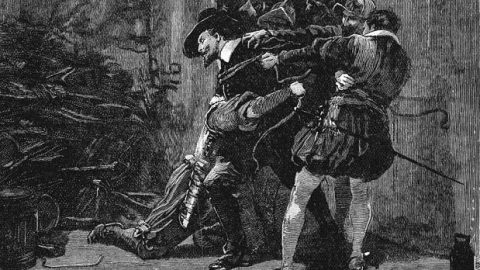How Guy Fawkes got caught

In the sleek, modern headquarters of the National Archives in London lies a threadbare grey leather pouch with faded lettering. Though it doesn’t look like much, this little bag holds the keys to one of history’s most daring conspiracies: the Gunpowder Plot. In 1605, Catholic sympathizer Guy Fawkes and his fellow conspirators planned to blow up the Houses of Parliament and kill the Protestant King James I and his council. The contents of this unassuming sack reveal the whole traitorous scheme—changing the course of English history forever.
Known as a Bag of Secrets, or Baga De Secretis, the first mention of these small pouches was made in 1344, and 91 Bags of Secrets were eventually used in England. Despite their name, the earliest bags didn’t hold sensitive files. Instead, they contained important documents relating to everyday cases of the King’s Bench, the country’s most senior criminal court. But that all changed in the 16th century during the reign of King Henry VIII.
Alarmed by what he saw as plots against the Tudors, Henry VIII ordered that the Bags of Secrets be used to store records for only the most consequential political trials of the day, including the trials of his second wife, Anne Boleyn, and his former minister, Thomas More. Only three people had keys to the Westminster closet where the bags were kept: the chief justice of the King’s Bench, the attorney general, and the master of the Crown Office. Now housed at the National Archives, one of the most important Bags of Secrets contains the records exposing and convicting the Catholic sympathizers behind the Gunpowder Plot.
For more than a century, England had been in conflict over its religious identity, ever since Henry VIII broke from the Catholic Church and set up the Protestant Church of England in 1534. At the turn of the 17th century, the conspirators of the Gunpowder Plot hoped to establish Catholic rule in England by killing King James and placing the King’s nine-year-old daughter Elizabeth on the throne under the watchful eye of Catholic leaders.
As early as 1603, prominent Catholic leader, Robert Catesby, began planning the Gunpowder Plot. By 1605, Catesby assembled a team of co-conspirators, including Guy, or Guido, Fawkes. The group leased a cellar directly beneath the House of Lords and filled it with 36 barrels of gunpowder—enough explosives to destroy the Palace of Westminster, Westminster Abbey, and much of the surrounding streets in a 50-yard radius.
Ten days before the conspirators planned to blow up Parliament, a mysterious letter was sent to Lord Monteagle, a Catholic member of the House of Lords. The missive warned him not to attend, “for they shall recyeve a terrible blowe this parleament and yet they shall not seie who hurts them.” A spooked Monteagle promptly squealed to the King.
On November 5, 1605, crown officials searched the surrounding buildings and discovered Fawkes with a lantern crouching over the gunpowder barrels. Fawkes soon became the face of treason around the country and was sentenced to be hung, drawn, and quartered, along with other co-conspirators. He dodged this gruesome fate by throwing himself from the gallows and breaking his neck. But his body was quartered anyway, and the pieces were sent to four corners of the country.
The Gunpowder Plot’s Bag of Secrets contains several crucial documents from the plot: the letter warning Monteagle, a notebook where King James authorized Fawkes’s torture, and Fawkes’s subsequent confession. In James’s notebook, the King instructed William Wade, a high-ranking official at the Tower of London, that “if [Fawkes] will not other ways confesse, the gentler tortures are first to be used upon him, and then step by step you may employ the harsher, and so speede youre goode work.”

Wade was an experienced inquisitor, who often used tortures such as the rack on prisoners. After five days of his “good work,” Fawkes confessed to conspiring against the crown but refused to give up the names of his co-conspirators (though spies later discovered the names of the other plotters). Traditional tellings say a haughty Fawkes told the King that he would have blown His Royal Highness all the way to Scotland’s northern mountains. But Fawkes’s shaky signature tells a different story. “Fawkes’s contorted and faint signature on this confession is witness to the agonies he must have suffered,” says Daniel Gosling, legal records specialist at the National Archives.
Perhaps the most significant document in the Bag of Secrets is the original Act for Public Thanksgiving passed in 1606. “The act was passed to ensure that no treason was attempted again. It made November 5th a public holiday. The public were required to attend church, give thanks to God for saving the King, and celebrate the failure of the plot,” says Gosling.
After the plot was exposed, England’s Protestant identity was largely unquestioned. Parliament handed over more money to the cause, and anti-Catholic laws were introduced.
Today, November 5th is known as Bonfire Night in England. Effigies of Fawkes, nicknamed “guys,” are set alight across the country. The holiday even spawned a popular 18th-century nursery rhyme: “Remember, remember! The fifth of November, the Gunpowder treason and plot; I know of no reason why the Gunpowder treason should ever be forgot!”
While only three people had access to the Gunpowder Plot’s Bag of Secrets in the 17th century, today anyone who visits the National Archives can request to see the mysterious bag. After centuries of being hidden out of sight, this Bag of Secrets is a secret no longer.
This article originally appeared on Atlas Obscura, the definitive guide to the world’s hidden wonder. Sign up for Atlas Obscura’s newsletter.





